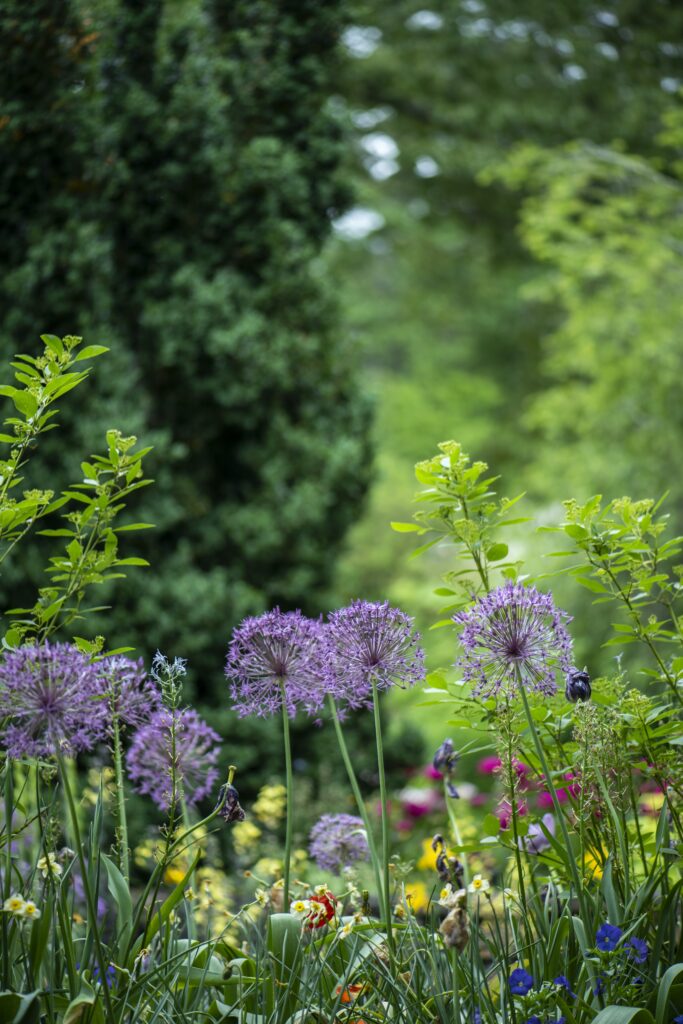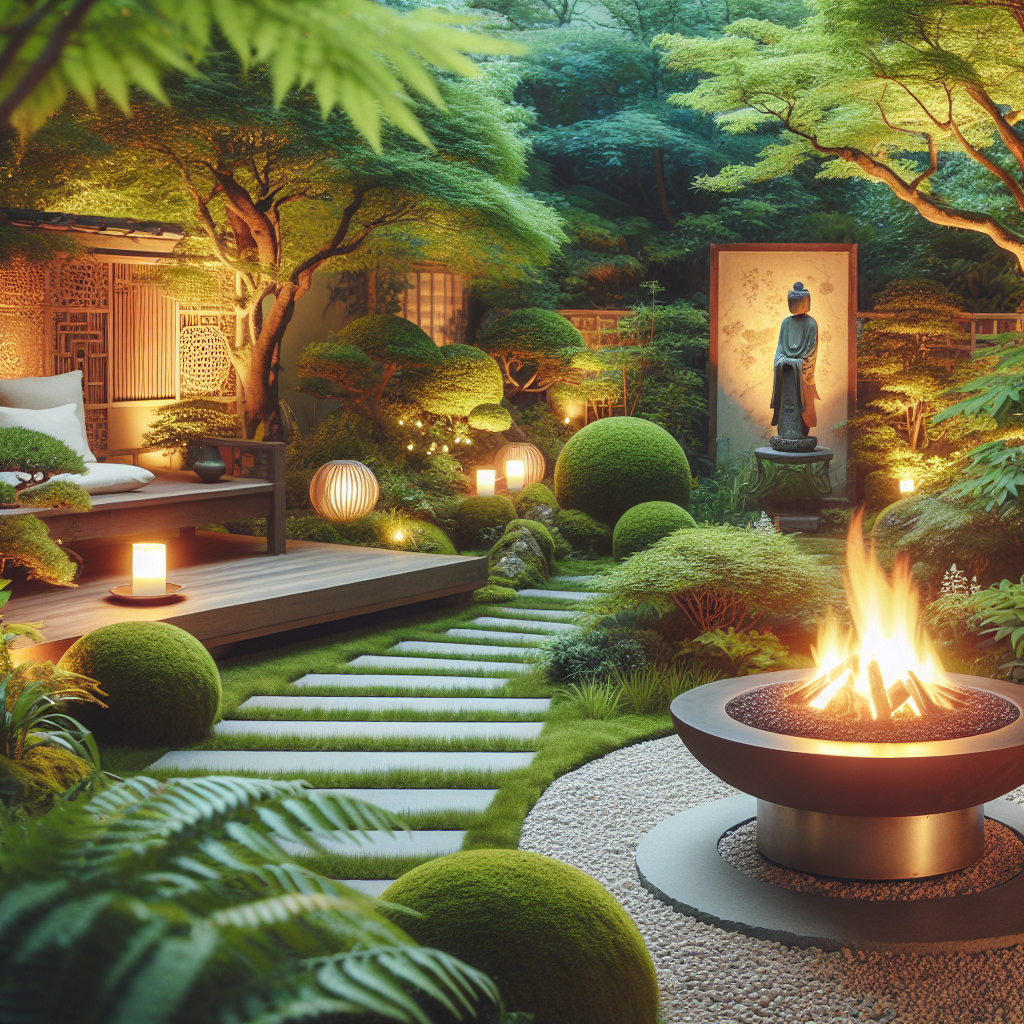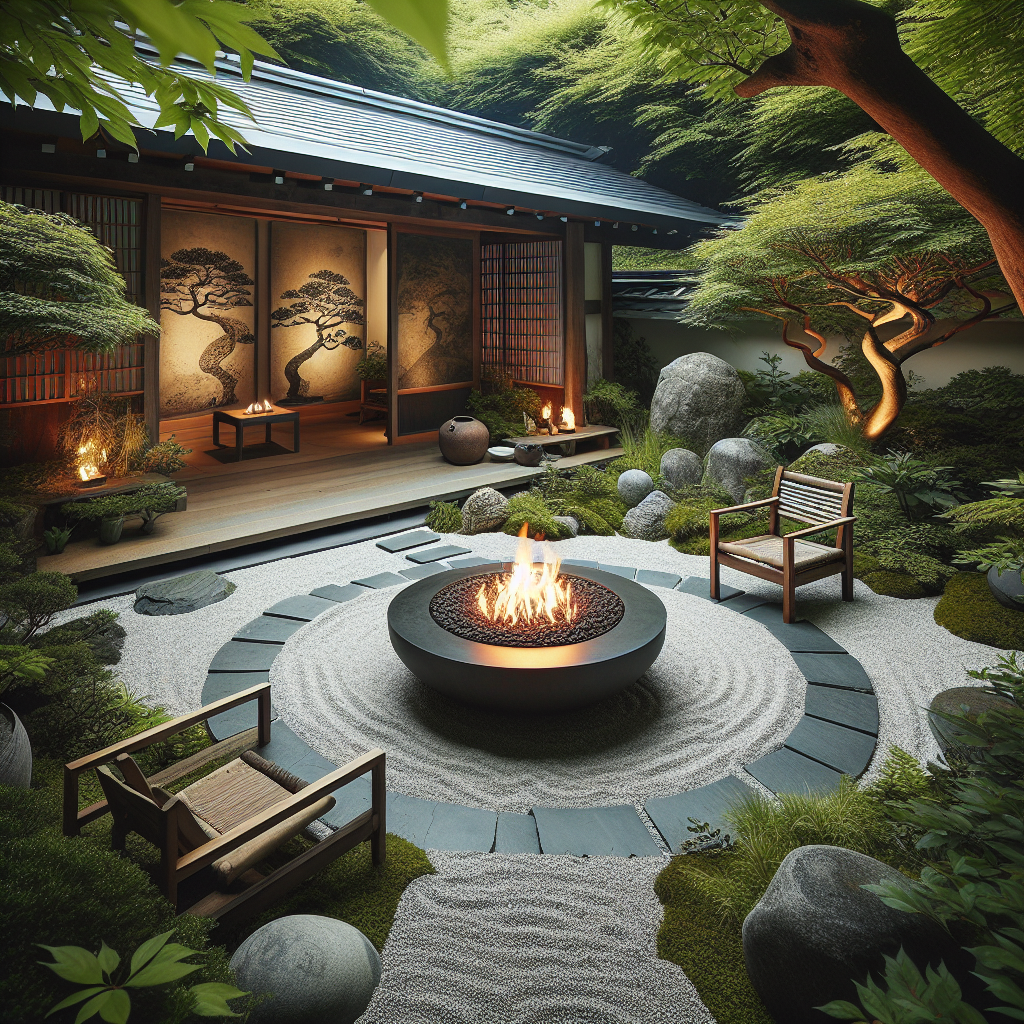Imagine creating a sanctuary, a tranquil space where you can unwind and find inner peace. Now, envision adding a touch of warmth and enchantment to this serene oasis. This is where the idea of incorporating a fire pit into your Zen garden or meditation space comes into play. By embracing the gentle flickering of flames, you can elevate your experience and immerse yourself in an ambiance that promotes relaxation and mindfulness. So, how exactly can you bring together the elements of fire and Zen in perfect harmony? Let’s explore some creative ideas to infuse your meditation space with the soothing presence of a fire pit.

Design considerations
When incorporating a fire pit into a zen garden or meditation space, there are several design considerations to keep in mind. These considerations include selecting the right location, determining the size and shape, choosing appropriate materials, and ensuring proper ventilation and safety measures.
Selecting the right location
The first step in incorporating a fire pit into a zen garden or meditation space is selecting the right location. The fire pit should be placed in an area that is easily accessible and provides a clear view of the flames. It is important to consider factors such as wind patterns and proximity to flammable materials when choosing the location.
Determining the size and shape
The size and shape of the fire pit should be carefully considered to ensure that it harmonizes with the overall design of the zen garden or meditation space. A smaller fire pit may be more suitable for intimate spaces, while a larger fire pit can create a focal point in a larger garden. The shape of the fire pit can also be chosen to complement the surrounding elements.
Choosing appropriate materials
When selecting materials for the fire pit, it is important to choose options that are durable and can withstand high temperatures. Common materials used for fire pits include stone, brick, and metal. It is also important to consider the aesthetic appeal of the materials and choose ones that blend well with the overall design of the zen garden or meditation space.
Ensuring proper ventilation and safety measures
Proper ventilation is crucial when incorporating a fire pit into a zen garden or meditation space. The fire pit should be designed in a way that allows for adequate airflow to prevent the buildup of smoke and carbon monoxide. Additionally, safety measures such as installing a spark screen and ensuring a safe distance from flammable materials should be taken into consideration.
Creating a harmonious layout
Once the design considerations have been addressed, creating a harmonious layout is essential when incorporating a fire pit into a zen garden or meditation space. This includes balancing elements, integrating the fire pit with water features, considering surrounding plants and foliage, and strategically positioning the fire pit for optimal relaxation.
Balancing elements
In a zen garden or meditation space, it is important to create a sense of balance and harmony. This can be achieved by placing the fire pit in relation to other elements such as rocks, plants, and seating areas. The fire pit should be positioned in a way that complements the overall layout and does not overwhelm the space.
Integrating fire pit with water features
Water features such as ponds, waterfalls, or fountains can be seamlessly integrated with a fire pit to create a harmonious design. Placing the fire pit near a koi pond or incorporating fire bowls with water features can enhance the visual appeal and create a tranquil atmosphere.
Considering surrounding plants and foliage
Plants and foliage play a crucial role in creating a serene and natural environment in a zen garden or meditation space. The fire pit should be positioned in a way that takes into account the surrounding plants and foliage, ensuring that they are not damaged by the heat or smoke.
Strategic positioning for optimal relaxation
The strategic positioning of the fire pit is important for creating optimal relaxation in a zen garden or meditation space. It should be placed in a way that allows for comfortable seating and unobstructed views of the flames. Careful consideration should be given to the direction and angle of the seating areas to maximize the calming effects of the fire pit.
Selecting the right type of fire pit
When incorporating a fire pit into a zen garden or meditation space, it is essential to select the right type of fire pit that aligns with the aesthetic and functional requirements. There are various types of fire pits available, including traditional wood-burning fire pits, gas-powered fire pits, ethanol fire pits, and sculptural and artistic fire pits.
Traditional wood-burning fire pits
Traditional wood-burning fire pits offer a rustic and natural ambiance. They provide a mesmerizing crackling sound and the scent of burning wood, which can enhance the overall experience in a zen garden or meditation space. However, they require regular maintenance and proper venting for the smoke.
Gas-powered fire pits
Gas-powered fire pits offer convenience and ease of use. They can be ignited with a simple push of a button and provide a clean-burning flame without the hassle of wood or ash cleanup. Gas fire pits also allow for adjustable flame height and temperature control, providing flexibility in creating the desired ambiance.
Ethanol fire pits
Ethanol fire pits are an environmentally friendly option for incorporating a fire pit into a zen garden or meditation space. They burn clean and do not produce any smoke or harmful emissions. Ethanol fire pits are also portable and can be easily moved to different locations within the garden or space.
Sculptural and artistic fire pits
For those looking to make a bold statement in their zen garden or meditation space, sculptural and artistic fire pits are an excellent choice. These fire pits are designed as works of art and can serve as focal points in the garden. They come in various shapes, sizes, and materials, allowing for customization to match the overall design theme.
Incorporating fire pit in traditional zen gardens
Incorporating a fire pit in traditional zen gardens requires careful consideration of design principles that emphasize minimalism, simplicity, and symbolism. This includes incorporating minimal elements, creating raked gravel patterns, placing stones strategically, and integrating the fire pit with meditation platforms.
Minimalism and simplicity
Zen gardens are known for their minimalist and simple design. When incorporating a fire pit, it is important to maintain this aesthetic by keeping the design clean and free of excessive ornamentation. The fire pit should blend seamlessly with the surrounding elements, creating a sense of tranquility.
Raked gravel patterns and symbolism
Raked gravel patterns are a common characteristic of traditional zen gardens. These patterns are created using a rake to represent the ripples of water or waves. When incorporating a fire pit, the gravel patterns can be extended to surround the fire pit, creating a symbolic representation of fire and water elements in harmony.
Stone arrangements and placement
Stones play a significant role in traditional zen gardens, symbolizing mountains or islands. When incorporating a fire pit, stones can be strategically arranged to enhance the overall design. The fire pit can be surrounded by stones of varying sizes and shapes, creating a visually pleasing arrangement.
Integration with meditation platforms
Meditation platforms provide a space for contemplation and relaxation in a zen garden. A fire pit can be integrated with a meditation platform by placing it nearby, offering warmth and a focal point for reflection. The fire pit should be positioned in a way that allows for comfortable seating and unobstructed views from the meditation platform.

Combining fire and water elements
Combining fire and water elements in a zen garden or meditation space can create a captivating and balanced design. This can be achieved by building a fire pit near a koi pond, incorporating cascading waterfalls with fire accents, integrating fire bowls with water features, and considering the symbolism of fire and water in Zen Buddhism.
Building a fire pit near a koi pond
One way to combine fire and water elements is by building a fire pit near a koi pond. The fire pit can be positioned in proximity to the pond, creating a stunning contrast between the warmth of the fire and the tranquility of the water. This combination symbolizes the harmony of opposing forces in nature.
Cascading waterfalls with fire accents
Cascading waterfalls with fire accents can add a dramatic and enchanting touch to a zen garden or meditation space. The waterfalls can flow into a pool or basin, while fire accents can be strategically placed to create a mesmerizing display. This combination represents the dynamic balance between movement and stillness.
Integrating fire bowls with water features
Integrating fire bowls with water features is another way to combine fire and water elements. Fire bowls can be placed on the edges of pools or fountains, creating a striking visual contrast. This combination symbolizes the coexistence of opposing energies and the interconnectedness of all things.
Fire and water symbolism in Zen Buddhism
In Zen Buddhism, fire and water symbolize transformation and purification. The combination of fire and water elements in a zen garden or meditation space can evoke feelings of renewal, cleansing, and enlightenment. When incorporating a fire pit, it is important to consider the symbolic significance of fire and water and their representation in Zen Buddhism.
Fire pit placement in meditation spaces
When incorporating a fire pit into a meditation space, careful consideration should be given to its placement to enhance the contemplative experience. The fire pit should serve as a focal point for contemplation, align with directional principles, optimize energy flow, and ensure safety and functionality.
Focal point for contemplation
A fire pit can serve as a focal point for contemplation in a meditation space. Its warm and mesmerizing flames can captivate attention and aid in focusing the mind. The fire pit should be located in a central position where it can be easily seen from different angles, allowing for uninterrupted contemplation.
Aligning with directional principles
In many meditation practices, the alignment of elements with the cardinal directions is significant. When incorporating a fire pit, it is important to consider the directional principles and align the fire pit accordingly. This alignment can enhance the spiritual and energetic aspects of the meditation space.
Positioning for optimal energy flow
Energy flow, often referred to as “chi” or “qi,” is an important concept in many meditation practices. When incorporating a fire pit, its positioning should take into account the principles of energy flow. It should be placed in a way that allows for the free flow of energy and does not create any obstructions or blockages.
Ensuring safety and functionality
Safety and functionality are crucial when incorporating a fire pit into a meditation space. The fire pit should be placed in a location that ensures safety and minimizes the risk of accidents. It should also be easily accessible for maintenance and fueling, allowing for optimal functionality and ease of use.

Enhancing the ambiance with lighting
In addition to the warm glow of the fire pit, incorporating appropriate lighting can further enhance the ambiance in a zen garden or meditation space. Soft and warm lighting options, such as lanterns and candles, can be used to create a mystical nighttime atmosphere. LED lights can also be incorporated for added convenience and flexibility.
Soft and warm lighting options
Soft and warm lighting options, such as lanterns and candles, can create a soothing and tranquil atmosphere in a zen garden or meditation space. These lighting options can be strategically placed around the fire pit to enhance the overall ambiance and create a sense of calm and serenity.
Using lanterns and candles
Lanterns and candles provide a gentle and flickering light that adds to the meditative atmosphere. The soft glow of lanterns can be placed on pathways or near seating areas to illuminate the surroundings. Candles can be arranged around the fire pit to create a cozy and intimate setting.
Incorporating LED lights
LED lights offer versatility and flexibility when it comes to enhancing the ambiance in a zen garden or meditation space. They can be used to highlight specific areas, such as the fire pit or surrounding plants, and can be controlled to adjust the brightness and color temperature. LED lights are also energy-efficient and can last for a long time.
Creating a mystical nighttime atmosphere
To create a mystical nighttime atmosphere in a zen garden or meditation space, a combination of soft and warm lighting options can be used. The combination of the warm glow of the fire pit, lanterns, candles, and LED lights can transform the space into a magical and enchanting setting, perfect for relaxation and contemplation.
Maintenance and care
Regular maintenance and care are essential to ensure the longevity and safety of a fire pit in a zen garden or meditation space. This includes regular cleaning and debris removal, ensuring proper ventilation, inspecting gas lines and connections (if applicable), and protecting the fire pit during harsh weather conditions.
Regular cleaning and debris removal
Regular cleaning and debris removal are necessary to keep the fire pit in optimal condition. Ashes and debris should be regularly removed to prevent blockages and ensure proper ventilation. The fire pit should be cleaned using appropriate tools and materials to avoid any damage to the surrounding elements.
Ensuring proper ventilation
Proper ventilation is crucial for the safe operation of a fire pit. The vents and airflow passages should be regularly checked and cleaned to prevent the buildup of smoke and carbon monoxide. It is important to follow the manufacturer’s guidelines for ventilation and ensure that the fire pit is properly vented.
Inspecting gas lines and connections
If the fire pit is gas-powered, regular inspection of gas lines and connections is necessary to ensure safety. Gas lines should be checked for leaks or damage, and connections should be tightened as needed. It is recommended to have a professional perform a thorough inspection at least once a year.
Protecting the fire pit during harsh weather
During harsh weather conditions, such as heavy rain or snow, it is important to protect the fire pit to prevent damage. Depending on the type of fire pit, protective covers or shelters can be used to shield it from the elements. It is also advisable to remove any flammable materials from the surrounding areas to minimize the risk of fire.

Safety considerations
Safety should always be a top priority when incorporating a fire pit into a zen garden or meditation space. It is important to keep a safe distance from flammable materials, know and use proper extinguishing methods, install fire-resistant barriers, and adhere to local fire safety regulations.
Keeping a safe distance from flammable materials
When placing a fire pit in a zen garden or meditation space, it is important to keep a safe distance from flammable materials. This includes vegetation, trees, buildings, and other structures. A clear space should be maintained around the fire pit to prevent accidental fires and ensure the safety of the surrounding area.
Proper extinguishing methods
Knowing and using proper extinguishing methods is crucial in case of an emergency. It is important to have fire extinguishing equipment readily available and to be knowledgeable about its proper use. The fire pit should be equipped with a means to extinguish the flames quickly and safely, such as a fire extinguisher or a bucket of sand.
Installing fire-resistant barriers
Installing fire-resistant barriers can provide an additional layer of safety when incorporating a fire pit into a zen garden or meditation space. Fire-resistant materials, such as fire bricks or metal screens, can be used to create a barrier around the fire pit, preventing sparks and embers from escaping and reducing the risk of fire spread.
Adhering to local fire safety regulations
Before incorporating a fire pit into a zen garden or meditation space, it is important to research and adhere to local fire safety regulations. Different areas may have specific regulations regarding the use of fire pits, such as setback distances, fuel types, and operating hours. Compliance with these regulations is essential to ensure the safety of the space and surrounding environment.
Creating a serene atmosphere
Incorporating a fire pit into a zen garden or meditation space is ultimately about creating a serene and peaceful atmosphere. In addition to the design elements mentioned earlier, there are several additional factors that can contribute to the overall serenity of the space. These factors include incorporating a natural soundscape, using calming scents and aromatherapy, softening the surroundings with plants, and designing comfortable seating areas.
Incorporating natural soundscape
A natural soundscape can greatly enhance the serenity of a zen garden or meditation space. This can be achieved by incorporating elements such as wind chimes, flowing water from a fountain, or natural sounds from nearby wildlife. The gentle sounds of nature can help create a peaceful and calming environment for meditation and relaxation.
Using calming scents and aromatherapy
Certain scents have been shown to promote relaxation and a sense of calm. In a zen garden or meditation space, calming scents can be incorporated through the use of essential oils, incense, or scented candles. Scents such as lavender, chamomile, and sandalwood are known for their soothing and relaxing properties.
Softening the surroundings with plants
Plants can play an important role in softening the surroundings and creating a tranquil atmosphere in a zen garden or meditation space. Soft, flowing foliage and gentle blooms can add a touch of natural beauty and create a sense of serenity. Carefully selecting plants that thrive in the environment will ensure that they continue to enhance the overall ambiance.
Designing comfortable seating areas
Comfortable seating areas are essential for creating a serene atmosphere in a zen garden or meditation space. Whether it’s a simple cushion on the ground, a bench, or a reclining chair, the seating area should be designed to promote relaxation and comfort. It should be positioned in a way that allows for a clear view of the fire pit and the surrounding elements.



